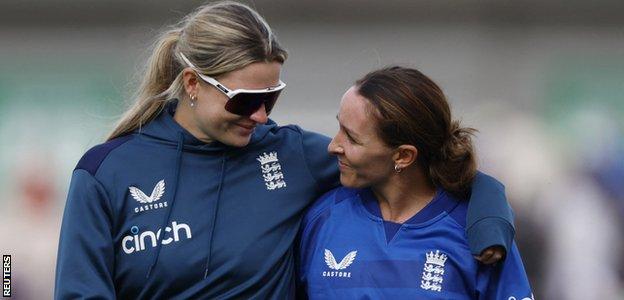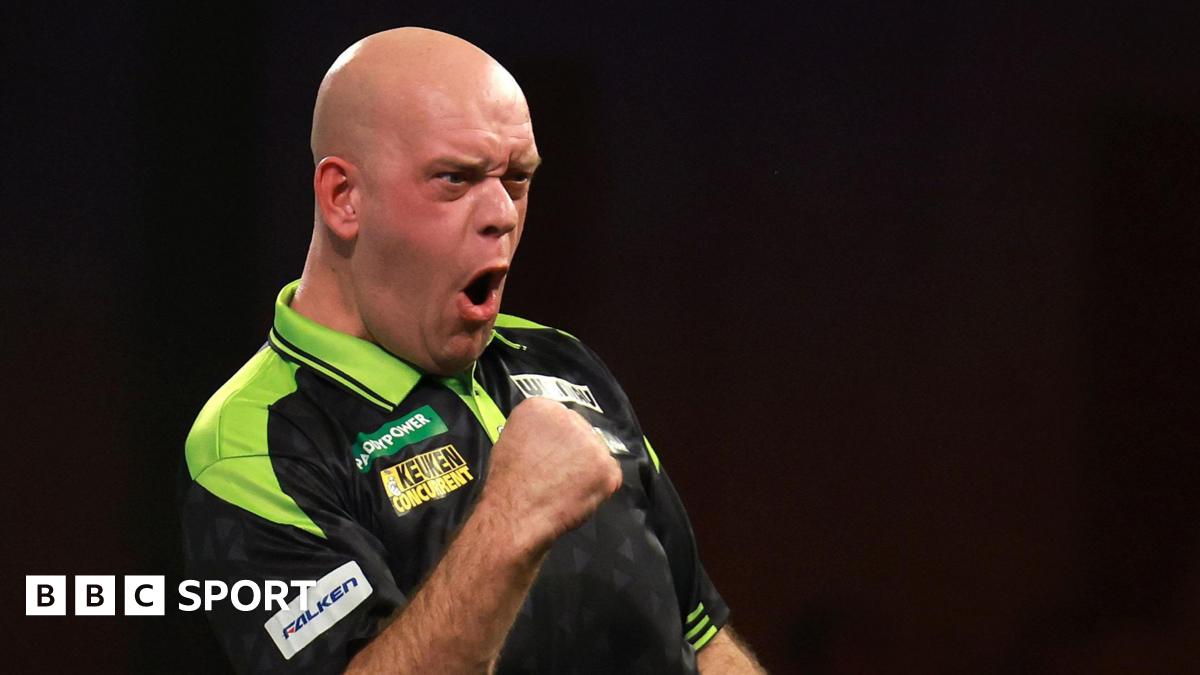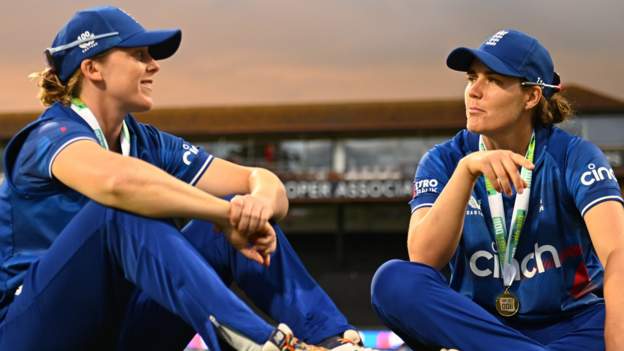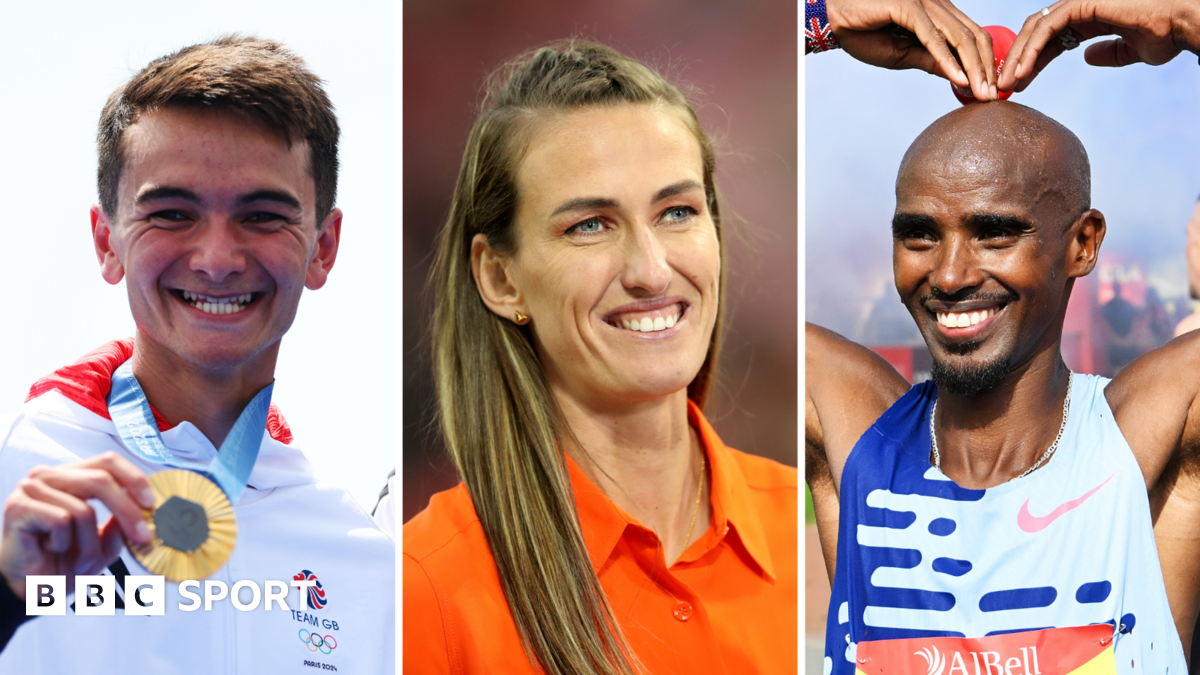It was the key question posed to both captains after the drawn Women’s Ashes series – have England closed the gap on all-conquering Australia?
Australia arrived in the UK this summer regarded by many as one of sport’s greatest sides.
They left with the Ashes urn still in their possession but having lost both white-ball series against England, their one-day series loss being their first in a bilateral contest since 2013.
So how have England achieved what many thought was impossible?
Jon Lewis improves every department
‘Bazball’ is the buzz word of the English summer in men’s cricket, and the style of play which has been so successful for Ben Stokes’ side has been adapted and adopted by captain Heather Knight and her team.
The man who has introduced this is head coach Jon Lewis, who was part of Brendon McCullum’s revolution before taking charge of the women’s team.
Neither McCullum nor Lewis like the term Bazball – or ‘Jonball’ as Lewis’ variation has been nicknamed – but there’s little doubt they have transformed the way England’s men and women play their cricket.
In its simplest form, it’s about controlled aggression with the bat and a desire to take every single opposition wicket with the ball.
Bowlers should be proactive rather than reactive. Defensive fields, lines and lengths just do not fly.
Under Lewis, England’s Test, one-day international and T20 batting run-rates have improved, but dig a little deeper and it’s clear the positive option is as controlled as it is successful.
England’s Test strike-rate (58.81) in the one-off match against Australia was higher than in any other Test in which records were taken.
That’s more than their 54.95 strike-rate in the last Ashes series down under, and far in advance of the 39.66 England scored their runs at in the previous home Ashes series in 2019.
Interestingly, however, England played fewer attacking shots than in the most recent Ashes Test in Australia (43% compared to 50%), underlining the McCullum/Lewis theory of clarity not carelessness.
In the T20s, for the second successive series, England scored at more than eight runs an over, having never previously touched such numbers (see red bars, which highlight when Lewis was in charge, in chart below).
England’s T20 run-rates
Source: Cricviz
One of the biggest success stories of the Lewis reign is 32-year-old batter Danni Wyatt.
So often seen as a white-ball specialist, she was handed her Test debut this summer and has seen her strike-rate improve in T20 and ODI cricket under Lewis.
She ended the one-day series with a confident 43 off 25 balls which proved crucial in England’s victory.
Danni Wyatt’s strike-rates
* Did not play any ODIs in 2020
Source: Cricinfo
Spin sisters shine once again
England’s fightback from losing the solitary Test and first T20 coincided with a recall for Charlie Dean and the hosts going with three spinners, Sophie Ecclestone and Sarah Glenn being the other two.
The fact all bring something different is a key strength for England. World number one Ecclestone is a left-arm spinner, Glenn a leg-spinner and Dean an off-spinner.
Since Lewis took over, England’s spinners have excelled in all formats. They took 18 wickets at an average of 11.27 on the winter tour to the West Indies, 22 at 14.68 in the T20 World Cup in South Africa – a country not known for being especially suited to spin bowling – and in all Ashes matches this summer they have 31 wickets.
England’s spinners have been more expensive yet more potent in this year’s Ashes.
“It does help when you have the best spinner in the world (Sophie Ecclestone) in your side,” said England World Cup winner Alex Hartley.
“England are now backing Sarah Glenn in ODI cricket too, so that’s a shift.
“In the spin department, England and Australia are evenly matched, but Ecclestone gives England such an edge.”
In a classic case of ‘if you can’t beat them, join them’, Australia turned to leg-spinner Alana King in Sunday’s decisive second one-day international.
The result was a player-of-the-match display and a series-deciding win.
It’s also worth highlighting the colossal impact of Australia’s own spin star Ashleigh Gardner, who took 23 wickets in the series.
Without her, England might now be in possession of the urn. But her success highlighted the deficiencies of Australia’s pace bowling stocks…
Bell tolls for England as Filer impresses in the fast lane
Australia’s recent dominance coincided with the latter stages in the career of England fast bowling legends Anya Shrubsole and Katherine Sciver-Brunt.
With both now retired, Kate Cross and Lauren Bell have stepped up to lead the attack.
Bell, 22, took 14 wickets across this year’s Ashes series, which is more than Australia’s Megan Schutt, Darcie Brown and Ellyse Perry combined.

“England had the big task of filling the void left by Shrubsole/Brunt, especially for the consistency those two offered over a number of years,” said ex-Australia batter Alex Blackwell.
“But I have seen signs of Lauren Bell being able to do that as she is growing in confidence. Her ability to bowl with discipline has had a huge effect on this team.”
England also turned to exciting young pace bowler Lauren Filer in the Test, which saw an increased collective bowling speed of two miles per hour for the seam attack compared to the most recent two Tests England played.
“Lauren Filer provided some of the best entertainment during the Test when she was charging in with the crowd behind her, and she got Ellyse Perry out twice,” said Blackwell.
“Darcie Brown is Australia’s equivalent – their young tearaway – and she hasn’t quite been at her best, but she’s young and will learn control.
“They have also got a lot of depth, but Tayla Vlaeminck being injured has been a shame. Raw pace has been absent for Australia.”
The Lanning effect

England might have closed the gap in some key areas, but what is hard to quantify is the impact of Australia losing captain Meg Lanning for this series for medical reasons.
A titan with the bat – she averages 53.51 in one-day cricket – she has led Australia to unprecedented success as skipper and should be spoken about in the same breath as other great Australia captains like Allan Border, Steve Waugh and Ricky Ponting.
Her captaincy win percentage is a remarkable 80%, compared to the 55% success rate of her replacement in this series, Alyssa Healy.
Australia have also lost their head coach, Matthew Mott, and influential batter Rachael Haynes (retired) in the last year.
Mott, who is now the head coach of England men’s white-ball sides, has been replaced by Shelley Nitschke, with all-rounder Tahlia McGrath taking over from Haynes in the leadership group.
However, Blackwell said the loss of Lanning, while significant, has not been the main reason for the drawn series.
She said: “Meg has a different style to Healy, who is very fun and light-hearted, whereas Lanning is more ‘follow my lead’ and sets very high standards for herself and for others. It has been hugely successful for her, but I don’t think it is the difference.
“We saw Australia under pressure for moments in the Test, but Healy’s fearless style helped Australia at times.
“When she came out to bat in the second innings, Australia had lost a flurry of wickets and she was on a pair with two broken fingers – but she made a half-century from 60-odd balls. And that’s what Lanning has instilled in the team.
“They know they are never out of it until the very last ball; they will never give up. She is the ice-cool captain, but I haven’t seen a huge difference from that perspective between her and Healy.”
While Australia dropped more chances in this series than in recent years under Lanning’s stewardship, they still retained an edge over England in the fielding department.
| Test | ODIs | T20s | Total | |
| England | 9 | 10 | 7 | 26 |
| Australia | 2 | 9 | 11 | 22 |
So have England closed the gap?
All-rounder Nat Sciver-Brunt – imperious for England all summer, especially in the one-day series as she scored successive centuries – thinks so, although she concedes there is still work to be done.
“I would say we’re not that far apart,” said Sciver-Brunt, speaking before the final ODI.
“As long as keep our intent and the way that we play there isn’t too much of a gap.
“When pressure moments are on, they’ve probably still got the edge on us a little bit.
“We’ve obviously got over the line in some close games but probably not done it as convincingly as we’d have liked to.
“But I guess we’re still on that learning curve a little bit – about how we, as individuals, go about those pressure moments at specific times.”
Perhaps, however, the final word should go to Australia’s player of the series, Gardner.
Speaking at Tuesday’s post-match presentation, she said: “England have outplayed us and played a fearless brand of cricket, and it is something we should look at.”
The apprentices might just have taught the masters a lesson.




















